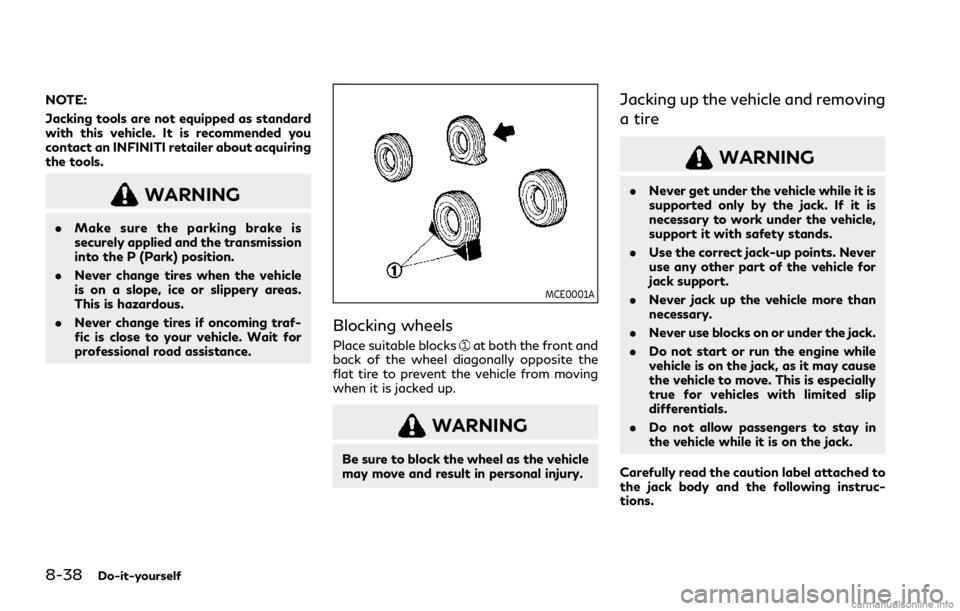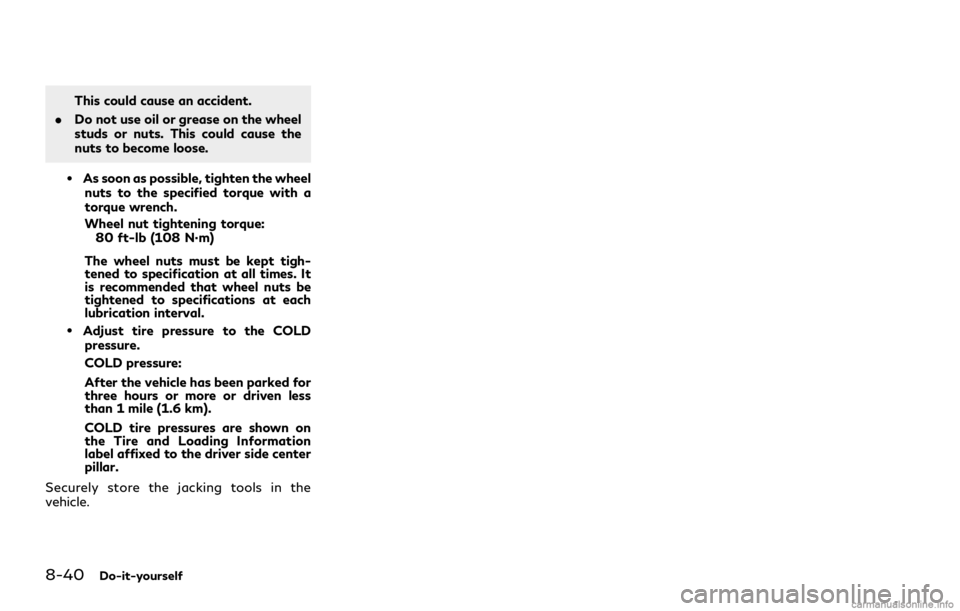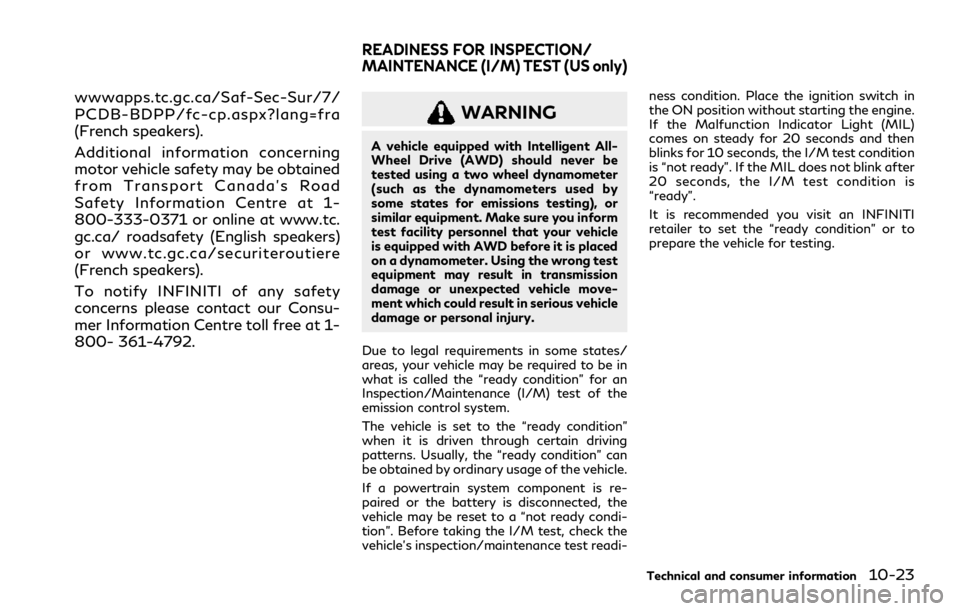ECU INFINITI Q50 2021 Repair Manual
[x] Cancel search | Manufacturer: INFINITI, Model Year: 2021, Model line: Q50, Model: INFINITI Q50 2021Pages: 484, PDF Size: 1.86 MB
Page 420 of 484

8-38Do-it-yourself
NOTE:
Jacking tools are not equipped as standard
with this vehicle. It is recommended you
contact an INFINITI retailer about acquiring
the tools.
WARNING
.Make sure the parking brake is
securely applied and the transmission
into the P (Park) position.
. Never change tires when the vehicle
is on a slope, ice or slippery areas.
This is hazardous.
. Never change tires if oncoming traf-
fic is close to your vehicle. Wait for
professional road assistance.
MCE0001A
Blocking wheels
Place suitable blocksat both the front and
back of the wheel diagonally opposite the
flat tire to prevent the vehicle from moving
when it is jacked up.
WARNING
Be sure to block the wheel as the vehicle
may move and result in personal injury.
Jacking up the vehicle and removing
a tire
WARNING
. Never get under the vehicle while it is
supported only by the jack. If it is
necessary to work under the vehicle,
support it with safety stands.
. Use the correct jack-up points. Never
use any other part of the vehicle for
jack support.
. Never jack up the vehicle more than
necessary.
. Never use blocks on or under the jack.
. Do not start or run the engine while
vehicle is on the jack, as it may cause
the vehicle to move. This is especially
true for vehicles with limited slip
differentials.
. Do not allow passengers to stay in
the vehicle while it is on the jack.
Carefully read the caution label attached to
the jack body and the following instruc-
tions.
Page 421 of 484

CE1089-A
Jack-up point
1. Place the jack directly under the jack-up point as illustrated so the top of the jack
contacts the vehicle at the jack-up point.
Align the jack head between the two
notches in the front or the rear as shown.
Also fit the groove of the jack head
between the notches as shown.
The jack should be used on level firm
ground.SCE0504
2. Loosen each wheel nut one or two turnsby turning counterclockwise with the
wheel nut wrench. Do not remove the
wheel nuts until the tire is off the
ground.
3. Carefully raise the vehicle until the tire clears the ground. To lift the vehicle,
securely hold the jack lever and rod with
both hands as shown above. Remove the
wheel nuts, and then remove the tire.
Installing a tire
1. Clean any mud or dirt from the surface
between the wheel and hub.
2. Carefully put the tire on and tighten the wheel nuts finger tight. 3. With the wheel nut wrench, tighten
wheel nuts alternately and evenly in the
sequence illustrated (
,,,,) until
they are tight.
4. Lower the vehicle slowly until the tire touches the ground. Then, with the
wheel nut wrench, tighten the wheel
nuts securely in the sequence as illu-
strated. Lower the vehicle completely.
WARNING
.Incorrect wheel nuts or improperly
tightened wheel nuts can cause the
wheel to become loose or come off.
Do-it-yourself8-39
Page 422 of 484

8-40Do-it-yourself
This could cause an accident.
. Do not use oil or grease on the wheel
studs or nuts. This could cause the
nuts to become loose.
.As soon as possible, tighten the wheel
nuts to the specified torque with a
torque wrench.
Wheel nut tightening torque: 80 ft-lb (108 N·m)
The wheel nuts must be kept tigh-
tened to specification at all times. It
is recommended that wheel nuts be
tightened to specifications at each
lubrication interval.
.Adjust tire pressure to the COLD pressure.
COLD pressure:
After the vehicle has been parked for
three hours or more or driven less
than 1 mile (1.6 km).
COLD tire pressures are shown on
the Tire and Loading Information
label affixed to the driver side center
pillar.
Securely store the jacking tools in the
vehicle.
Page 424 of 484

9-2Maintenance and schedules
Some day-to-day and regular maintenance
is essential to maintain your vehicle in good
mechanical condition, as well as its emission
and engine performance.
It is the owner’s responsibility to make sure
that the scheduled maintenance, as well as
general maintenance, is performed.
As the vehicle owner, you are the only one
who can ensure that your vehicle receives
the proper maintenance. You are a vital link
in the maintenance chain.
GENERAL MAINTENANCE
General maintenance includes those items
which should be checked during normal day-
to-day operation. They are essential for
proper vehicle operation. It is your respon-
sibility to perform these procedures regularly
as prescribed.
Performing general maintenance checks re-
quires minimal mechanical skill and only a
few general automotive tools.
These checks or inspections can be done by
yourself, a qualified technician or, if you
prefer, an INFINITI retailer.
SCHEDULED MAINTENANCE
The maintenance items listed in this section
are required to be serviced at regular inter-
vals. However, under severe driving condi-
tions, additional or more frequent
maintenance will be required.
WHERE TO GO FOR SERVICE
If maintenance service is required or your
vehicle appears to malfunction, have the
systems checked and serviced. It is recom-
mended you visit an INFINITI retailer for this
service.
INFINITI technicians are well-trained spe-
cialists and are kept up to date with the
latest service information through technical
bulletins, service tips and training programs.
They are completely qualified to work on
INFINITI vehiclesbeforework begins.
If your vehicle is involved in a collision, it is
recommended that you ask your INFINITI
retailer where the nearest INFINITI Certified
Collision Center is located, or go to http://
collision.infinitiusa.com.
You can be confident that an INFINITI
retailer’s service department can perform
the service needed to meet the maintenance
requirements on your vehicle. During the normal day-to-day operation of
the vehicle, general maintenance should be
performed regularly as prescribed in this
section. If you detect any unusual sounds,
vibrations or smells, be sure to check for the
cause and have it checked promptly. In
addition, it is recommended you visit an
INFINITI retailer if you think that repairs are
required.
When performing any checks or mainte-
nance work, closely observe “Maintenance
precautions” (P.8-2) of this manual.
EXPLANATION OF GENERAL
MAINTENANCE ITEMS
Additional information on the following
items with “*” is found in the “8. Do-it-
yourself” section of this manual.
Outside the vehicle
The maintenance items listed here should be
performed from time to time, unless other-
wise specified.
Doors and engine hood:
Check that all doors
and the engine hood, operate properly. Also
ensure that all latches lock securely. Lubri-
cate hinges, latches, latch pins, rollers and
links if necessary. Make sure that the
secondary latch keeps the hood from open-
ing when the primary latch is released.
When driving in areas using road salt or
MAINTENANCE REQUIREMENT GENERAL MAINTENANCE
Page 425 of 484

other corrosive materials, check lubrication
frequently.
Lights*:Clean the headlights on a regular
basis. Make sure that the headlights, stop
lights, tail lights, turn signal lights, and other
lights are all operating properly and installed
securely. Also check headlight aim.
Road wheel nuts (lug nuts)*: When checking
the tires, make sure no wheel nuts are
missing, and check for any loose wheel nuts.
Tighten if necessary.
Tire rotation*: Rotate tires at the specified
interval shown in the maintenance schedule.
If your vehicle is equipped with different
sized tires in the front and rear, tires cannot
be rotated.
Tires*: Check the pressure with a gauge
often and always prior to long distance trips.
If necessary, adjust the pressure in all tires,
including the spare, to the pressure speci-
fied. Check carefully for damage, cuts or
excessive wear.
Tire Pressure Monitoring System (TPMS)
transmitter components: Replace the TPMS
transmitter grommet seal, valve core and
cap when the tires are replaced due to wear
or age.
Wheel alignment and balance: If the vehicle
should pull to either side while driving on a
straight and level road, or if you detect
uneven or abnormal tire wear, there may be a need for wheel alignment.
If the steering wheel or seat vibrates at
normal highway speeds, wheel balancing
may be needed.
For additional information regarding tires,
refer to “Important Tire Safety Information”
(US) or “Tire Safety Information” (Canada) in
the INFINITI Warranty Information Booklet.
Windshield:
Clean the windshield on a
regular basis. Check the windshield at least
every six months for cracks or other damage.
Have a damaged windshield repaired by a
qualified repair facility. It is recommended
that you have a damaged windshield re-
paired by an INFINITI retailer, or an INFINITI
Certified Collision Center. To locate a colli-
sion center in your area, refer to http://
collision.infinitiusa.com.
Windshield wiper blades*: Check for cracks
or wear if they do not wipe properly.
Inside the vehicle
The maintenance items listed here should be
checked on a regular basis, such as when
performing scheduled maintenance, cleaning
the vehicle, etc.
Accelerator pedal: Check the pedal for
smooth operation and make sure the pedal
does not catch or require uneven effort.
Keep the floor mat away from the pedal. Automatic transmission P (Park) mechan-
ism:
On a fairly steep hill, check that your
vehicle is held securely with the shift lever in
the P (Park) position without applying any
brakes.
Brake pedal: Check the pedal for smooth
operation. If the brake pedal suddenly goes
down further than normal, the pedal feels
spongy or the vehicle seems to take longer to
stop, have your vehicle checked immediately.
It is recommended you visit an INFINITI
retailer for this service. Keep the floor mat
away from the pedal.
Brakes: Check that the brakes do not pull the
vehicle to one side when applied.
Parking brake: Check the parking brake
operation regularly. The vehicle should be
securely held on a fairly steep hill with only
the parking brake applied. If the parking
brake needs adjusted, it is recommended you
visit an INFINITI retailer for this service.
Seats: Check seat position controls such as
seat adjusters, seatback recliner, etc. to
ensure they operate smoothly and that all
latches lock securely in every position. Check
that the head restraints move up and down
smoothly and that the locks (if so equipped)
hold securely in all latched positions.
Seat belts: Check that all parts of the seat
belt system (for example, buckles, anchors,
adjuster and retractors) operate properly
Maintenance and schedules9-3
Page 426 of 484

9-4Maintenance and schedules
and smoothly, and are installed securely.
Check the belt webbing for cuts, fraying,
wear or damage.
Steering wheel:Check for changes in the
steering conditions, such as excessive free
play, hard steering or strange noises.
Warning lights and chimes: Make sure that
all warning lights and chimes are operating
properly.
Windshield defroster: Check that the air
comes out of the defroster outlets properly
and in sufficient quantity when operating
the heater or air conditioner.
Windshield wiper and washer*: Check that
the wipers and washer operate properly and
that the wipers do not streak.
Under the hood and vehicle
The maintenance items listed here should be
checked periodically (for example, each time
you check the engine oil or refuel).
Battery*: Check the fluid level in each cell. It
should be between the MAX and MIN lines.
Vehicles operated in high temperatures or
under severe condition require frequent
checks of the battery fluid level.
NOTE:
Care should be taken to avoid situations
that can lead to potential battery discharge
and potential no-start conditions such as: 1.
Installation or extended use of electro-
nic accessories that consume battery
power when the engine is not running
(Phone chargers, GPS, DVD players,
etc.)
2. Vehicle is not driven regularly and/or
only driven short distances.
In these cases, the battery may need to be
charged to maintain battery health.
Brake fluid level*: Make sure that the brake
fluid level is between the MAX and MIN lines
on the reservoir.
Engine coolant level*: Check the coolant
level when the engine is cold.
Intercooler coolant level*: Check the coolant
level when the engine is cold.
Engine drive belts*: Make sure that no belt is
frayed, worn, cracked or oily.
Engine oil level*: Check the level after
parking the vehicle on a level spot and
turning off the engine. Wait more than 15
minutes for the oil to drain back into the oil
pan.
Exhaust system: Make sure there are no
loose supports, cracks or holes. If the sound
of the exhaust seems unusual or there is a
smell of exhaust fumes, immediately have
the exhaust system inspected. It is recom-
mended you visit an INFINITI retailer for this
service. (See “Precautions when starting and driving” (P.5-4).)
Fluid leaks:
Check under the vehicle for fuel,
oil, water or other fluid leaks after the
vehicle has been parked for a while. Water
dripping from the air conditioner after use is
normal. If you should notice any leaks or if
gasoline fumes are evident, check for the
cause and have it corrected immediately.
Radiator and hoses: Check the front of the
radiator and clean off any dirt, insects,
leaves, etc., that may have accumulated.
Make sure the hoses have no cracks, defor-
mation, rot or loose connections.
Underbody: The underbody is frequently
exposed to corrosive substances such as
those used on icy roads or to control dust. It
is very important to remove these sub-
stances, otherwise rust will form on the
floor pan, frame, fuel lines and around the
exhaust system. At the end of winter, the
underbody should be thoroughly flushed
with plain water, being careful to clean
those areas where mud and dirt may accu-
mulate. For additional information, see
“Cleaning exterior” (P.7-2).
Windshield washer fluid*: Check that there
is adequate fluid in the reservoir.
Page 461 of 484

for your vehicle. (See “Measurement
of weights” (P.10-19).)
Also check tires for proper inflation
pressures. See the Tire and Loading
Information label.
LOADING TIPS
.The GVW must not exceed GVWRor GAWR as specified on the F.M.
V.S.S./C.M.V.S.S. certification la-
bel.
.Do not load the front and rear axleto the GAWR. Doing so will exceed
the GVWR.
WARNING
.Properly secure all cargo to help
prevent it from sliding or shift-
ing. Do not place cargo higher
than the seatbacks. In a sudden
stop or collision, unsecured car-
go could cause personal injury.
.Do not load your vehicle any
heavier than the GVWR or the
maximum front and rear
GAWRs. If you do, parts of your vehicle can break, tire
damage could occur, or it can
change the way your vehicle
handles. This could result in loss
of control and cause personal
injury.
.Overloading could not only
shorten the life of your vehicle
and the tires, but also could
lead to hazardous vehicle hand-
ling and long braking distance.
This may cause a premature tire
malfunction, which could result
in a serious accident and perso-
nal injury. Failures caused by
overloading are not covered by
the vehicle’s warranty.
MEASUREMENT OF WEIGHTS
Secure loose items to prevent weight
shifts that could affect the balance of
your vehicle. When the vehicle is
loaded, drive to a scale and weigh
the front and the rear wheels sepa-
rately to determine axle loads. Indivi-
dual axle loads should not exceed
either of the gross axle weight ratings(GAWR). The total of the axle loads
should not exceed the gross vehicle
weight rating (GVWR). These ratings
are given on the vehicle certification
label. If weight ratings are exceeded,
move or remove items to bring all
weights below the ratings.
Technical and consumer information10-19
Page 465 of 484

wwwapps.tc.gc.ca/Saf-Sec-Sur/7/
PCDB-BDPP/fc-cp.aspx?lang=fra
(French speakers).
Additional information concerning
motor vehicle safety may be obtained
from Transport Canada’s Road
Safety Information Centre at 1-
800-333-0371 or online at www.tc.
gc.ca/ roadsafety (English speakers)
or www.tc.gc.ca/securiteroutiere
(French speakers).
To notify INFINITI of any safety
concerns please contact our Consu-
mer Information Centre toll free at 1-
800- 361-4792.
WARNING
A vehicle equipped with Intelligent All-
Wheel Drive (AWD) should never be
tested using a two wheel dynamometer
(such as the dynamometers used by
some states for emissions testing), or
similar equipment. Make sure you inform
test facility personnel that your vehicle
is equipped with AWD before it is placed
on a dynamometer. Using the wrong test
equipment may result in transmission
damage or unexpected vehicle move-
ment which could result in serious vehicle
damage or personal injury.
Due to legal requirements in some states/
areas, your vehicle may be required to be in
what is called the “ready condition” for an
Inspection/Maintenance (I/M) test of the
emission control system.
The vehicle is set to the “ready condition”
when it is driven through certain driving
patterns. Usually, the “ready condition” can
be obtained by ordinary usage of the vehicle.
If a powertrain system component is re-
paired or the battery is disconnected, the
vehicle may be reset to a “not ready condi-
tion”. Before taking the I/M test, check the
vehicle’s inspection/maintenance test readi- ness condition. Place the ignition switch in
the ON position without starting the engine.
If the Malfunction Indicator Light (MIL)
comes on steady for 20 seconds and then
blinks for 10 seconds, the I/M test condition
is “not ready”. If the MIL does not blink after
20 seconds, the I/M test condition is
“ready”.
It is recommended you visit an INFINITI
retailer to set the “ready condition” or to
prepare the vehicle for testing.
Technical and consumer information10-23
READINESS FOR INSPECTION/
MAINTENANCE (I/M) TEST (US only)
Page 469 of 484

11 Index
A
ABS (Anti-lock Braking System) ................... 5-126
Active Lane Control ............................................ 5-25
Active noise cancellation ................................. 5-137
Active sound enhancement ............................ 5-137
Active trace control .......................................... 5-129
Air bag systemFront-seat mounted side-impact
upplemental air bag system ....................... 1-57
Roof-mounted curtain side-impact
supplemental air bag system ..................... 1-57
Air bag warning labels ....................................... 1-60
Air bag warning light .............................. 1-60, 2-12
Air cleaner housing filter ................................... 8-15
Air conditioner
Air conditioner operation ............................ 4-36
Air conditioner service ................................ 4-42
Air conditioner specification label ......... 10-13
Air conditioning system refrigerant and
lubricant recommendations ....................... 4-42
Air conditioning system refrigerant and
oil recommendations .................................... 10-7
Automatic air conditioner ........................... 4-37
DUAL mode setting ..................................... 4-40
Heater and air conditioner .......................... 4-36
Servicing air conditioner ............................. 4-42
Air deflectors ...................................................... 10-16 Alarm
How to stop alarm (see vehicle
security system) ............................................. 2-31
Alcohol, drugs and driving ................................ 5-10
Android Auto .......................................................... 4-2
Antenna .................................................................. 4-43
Anti-lock Braking System (ABS) ................... 5-126
Appearance care
Exterior appearance care ............................... 7-2
Interior appearance care ................................ 7-5
Apple CarPlay
®...................................................... 4-2
Armrest ...................................................................... 1-7
Around View
®Monitor ...................................... 4-11
Audible reminders ................................................. 2-17
Autolight system .................................................. 2-36
Automatic Automatic air conditioner ........................... 4-37
Automatic Transmission Fluid (ATF) ......... 8-9
Driving with automatic transmission ....... 5-16
Automatic door locks ............................................ 3-5
Automatic seat positioner ................................ 3-33
Avoiding collision and rollover ............................ 5-9
B
Back-up Collision Intervention (BCI) .............. 5-60
Battery .................................................................... 8-11
Battery replacement, Intelligent Key ......... 3-2
Battery saver system .................................... 2-39
Intelligent Key ................................................. 8-19 Variable voltage control system ............... 8-13
Before starting the engine ................................ 5-14
Belts (See drive belts) ......................................... 8-13
Blind Spot Intervention
®(BSI) ......................... 5-48
Blind Spot Warning (BSW) .............................. 5-40
Brake
Anti-lock Braking System (ABS) ............. 5-126
Brake fluid ...................................................... 8-10
Brake force distribution ............................ 5-128
Brake system ................................................ 5-125
Parking brake operation ............................. 5-20
Brake warning light .............................................. 2-11
Break-in schedule .............................................. 5-118
Bulb check/instrument panel ............................ 2-11
Bulb replacement ................................................. 8-22
C
Camera aiding sonar function ......................... 4-25
Capacities and
recommended fluids/lubricants ....................... 10-2
Car phone or CB radio ....................................... 4-43
Card holder ............................................................ 2-50
Catalytic converter Three-way catalyst ......................................... 5-5
Changing intercooler coolant ............................. 8-6
Chassis control ................................................... 5-131
Check tire pressure warning ............................. 2-22
Checking intercooler coolant level .................... 8-6
Page 474 of 484

11-6
Readiness for inspection/maintenance
(I/M) test (US only) .......................................... 10-23
Rear door lockChild safety rear door lock ........................... 3-6
Rear seats ................................................................. 1-5
Rear window and outside mirror
defroster switch ................................................... 2-35
RearView Monitor ................................................. 4-3
Recorders Event data .................................................... 10-24
Registering your vehicle in
another country ................................................. 10-11
Remote engine start ........................................... 3-19
Remote keyless entry system .......................... 3-15
Reporting safety defects ................................ 10-22
Request switch (See Intelligent
Key system) .............................................................. 3-9
Roadside assistance program ............................. 6-2
Rollover ..................................................................... 5-9
Roof Moonroof ......................................................... 2-55
Run-flat tires .......................................................... 6-4
S
Safety Child seat belts ............................................... 1-19
Reporting safety defects .......................... 10-22
Seat adjustment Front power seat adjustment ....................... 1-3
Front seats ......................................................... 1-3 Seat belt(s)
Child safety ..................................................... 1-19
Infants ............................................................... 1-20
Injured persons ............................................... 1-15
Larger children ............................................... 1-20
Pre-crash seat belts with
comfort function ............................................ 1-15
Precautions on seat belt usage ................. 1-12
Pregnant women ........................................... 1-15
Seat belt cleaning ............................................. 7-7
Seat belt extenders ....................................... 1-18
Seat belt maintenance ................................. 1-19
Seat belt warning light
and chime ............................................. 1-14, 2-12
Seat belts ......................................................... 1-12
Seat belts with pretensioners .................... 1-59
Shoulder belt height adjustment ............... 1-18
Small children .................................................. 1-20
Three-point type ............................................ 1-15
Seat(s) Driver-side memory ...................................... 3-33
Heated seats ................................................... 2-43
Seats .................................................................... 1-2
Security system Vehicle security system ............................... 2-30
Security system (INFINITI Vehicle
Immobilizer System) Engine start ..................................................... 2-31
Servicing air conditioner .................................... 4-42
Shift lever Shift lock release ........................................... 5-19 Shift lock release, Transmission ...................... 5-19
Shifting
Automatic transmission ............................... 5-16
Shoulder belt height adjustment ..................... 1-18
SNOW mode ......................................................... 5-22
Sonar system ...................................................... 5-132 Camera aiding sonar function
(models with Around View
®Monitor) ..... 4-25
Sonar system settings ...................................... 5-133
Spare tire ............................................................... 10-9
Spark plugs ............................................................ 8-14
Speedometer ............................................................ 2-7
SPORT mode ........................................................ 5-22
SPORT+ mode ...................................................... 5-22
Standard maintenance ......................................... 9-8
STANDARD mode ............................................... 5-22
Starting
Before starting the engine .......................... 5-14
Jump starting .................................................. 8-13
Precautions when starting and driving ..... 5-4
Push starting ...................................................... 6-7
Starting the engine ....................................... 5-15
Status light, Front passenger air bag ............ 1-50
Steering Direct Adaptive Steering ........................... 5-123
Heated steering wheel ................................ 2-44
Power steering system .............................. 5-123
Tilt/telescopic steering ................................ 3-27
Storage ................................................................... 2-48
Storage box ........................................................... 2-51
Sun visors ............................................................... 3-29